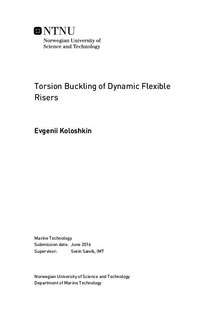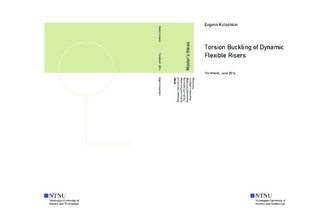Torsion Buckling of Dynamic Flexible Risers
| dc.contributor.advisor | Sævik, Svein | |
| dc.contributor.author | Koloshkin, Evgenii | |
| dc.date.accessioned | 2016-08-26T14:00:49Z | |
| dc.date.available | 2016-08-26T14:00:49Z | |
| dc.date.created | 2016-06-06 | |
| dc.date.issued | 2016 | |
| dc.identifier | ntnudaim:14886 | |
| dc.identifier.uri | http://hdl.handle.net/11250/2402196 | |
| dc.description.abstract | Themain purpose of this work is to contribute to better understanding of the torsion structural stability and kink formation process of flexible risers in catenary configuration. The thesis deals with installation criteria of offshore flexible lines (risers/cables) with focus on the torsion buckling behavior at the touch down point. The study includes both analytical and numerical investigations. The latter is carried out by means of the non-linear finite element program BFLEX2010. The physical nature of the torsion buckling of catenary risers has been thoroughly analyzed and described in the present work for the models with linear and non-linear material characteristics. It has been found that it is important to include the riser s section resting on the seabed to the models because it is subjected to friction forces influencing torsion buckling capacity. The numerical performance of the models obtained by BFLEX2010 software has been compared to the analytical solution represented by the Greenhill s equation. The limitation of the Greenhill s equation with respect to the torsion buckling at the TDP has been evaluated. Significant efforts have been dedicated to investigation of the effect of non-linear moment curvature behavior (the sliding process between riser s layers) on the process of torsion buckling. It has been found that the torsion buckling capacity is directly proportional to the value of the friction moment. The effect of cyclic heave motion of the laying vessel on kink formation process has also been studied at different levels of initial utilization of torsion reaction. Parametric numerical analysis showed that in some cases depending on heave amplitude and amount of initial torsion utilization there can be a severe consequences leading to kink formation. Therefore, the methodology called "Dynamic criterion" has been established for evaluation of the kink formation process and verified for the models with linearly elastic and non-linear material properties. Another important observation has been done from the cyclic heave motion analysis that the structure at the same time can have a compression in the TDP and remain safe against torsion failure modes. This conclusion challenges current offshore industry practice. | |
| dc.language | eng | |
| dc.publisher | NTNU | |
| dc.subject | Marine Technology, Marine Structures | |
| dc.title | Torsion Buckling of Dynamic Flexible Risers | |
| dc.type | Master thesis | |
| dc.source.pagenumber | 92 |
Files in this item
This item appears in the following Collection(s)
-
Institutt for marin teknikk [3397]

